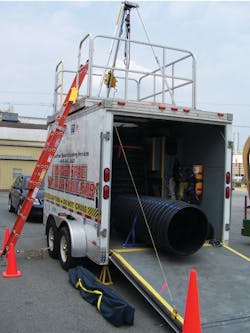Recently, media attention has focused on some confined-space rescue operations that went wrong. From May to September 2010, three high-profile confined-space rescues resulted in three deceased civilian workers, six injured rescuers and one fatality of a rescuer. What went so horribly wrong in these three incidents where so many lives were disrupted?
A person in need of help while in a tank, vessel, pit, manhole or other confined space is in a confined-space rescue situation. Confined space awareness and rescue training is a must for all responding rescuers. The game has changed from what it was 50 years ago.
Our hearts cannot dictate our actions, so we must clearly think through the situation and do a simple risk-benefit analysis. We must not tolerate the mentality of "risking a life to save a body." This may sound cruel, but at this point we are not even sure if we have a rescue or a recovery. Think before you react.
A rescue is defined as "to free from confinement, danger or evil." The Occupational Safety and Health Administration (OSHA) expects that a rescue should typically be conducted within four to six minutes, by most interpretations. For fire and rescue services, it is nearly impossible to receive an emergency call, respond, size-up the scene, set up equipment and conduct an effective rescue within four to six minutes.
In the 1910.146 standard for confined-space rescue, OSHA mandates that rescuers must be evaluated and meet certain criteria to even be qualified as the rescue team. If those criteria cannot be met, the employer would be forced to provide a site rescue team or bring the responding team into compliance.
As a fire officer, I can count on one hand the number of times an employer has contacted us to determine our rescue abilities at their confined-space work area. Yet, the fire and rescue team will still respond and attempt a rescue, risking their lives because that is what is expected. Where did we go wrong? A lack of training.
We need to revise the fire service training to include awareness training on many different topics just like this one.
A simple four-gas air monitor can identify what we cannot see, possible hazardous atmospheres. Workers are required to monitor the atmosphere prior to entry and so should the rescue team. There is no nice green cloud floating around inside the space that says "Hey, look at me! I am toxic!" We cannot see, smell or taste most of the hazardous atmospheres that we work in so the only way to identify a possible hazard is to monitor the air quality. This must be performed prior to the entry either by workers or rescuers.
Atmospheric conditions can change instantly and therefore what might have been safe five minutes ago may now cost you your life. Monitoring initially will tell you what the current conditions are in the space. Monitoring continuously will tell you any changes that may occur while you are conducting the rescue.
Continuous air monitoring is critical to identify the problem before it becomes a danger to you, letting you exit the space quickly and safely. All too often, though, we monitor the space initially, then put the monitor away thinking that everything is good. How quickly can the atmosphere inside a confined space change? Instantly! These simple procedures should apply to workers in the space or a rescue team needing to do entry.
After the atmosphere inside the space is tested, we must ensure that it stays in a safe range. At times, we can control this with the use of a blower. Blowers can be electric or gas. If you use a gas blower, consider a carbon monoxide (CO) monitor at the air intake to ensure that no CO is being pulled into your fresh-air supply. Your goal here is to provide as much fresh, non-contaminated air as possible into the confined space and hopefully turn the atmosphere inside the space over at least one time. With a blower providing fresh air and continuous air monitoring, we will have better control of the atmospheric hazards of the confined space.
While all this is taking place, your entry team should be preparing its gear, setting up its equipment, preparing the rescuer, preparing for medical coverage, controlling other possible hazards, securing the area and maintaining control of the situation. It is crucial to begin the atmospheric monitoring with the other setup duties to expedite a rescue.
Controlling the atmosphere is the most important part of all confined-space entry work. This is the main hazard that kills most workers and rescuers. This is also the most difficult to identify and the most widely forgotten due to the lack of being able to see the danger.
You are called to a rescue of a worker in a tank and upon arrival you find a mid-30s male lying face down in an empty and, by observation, hazard-free environment. What you don't see is the atmospheric hazard and soon find out the tank is oxygen deficient.
Are you the next victim? Workers and rescuers, employers and owners, entrants and attendants all must aggressively manage and control the atmospheric hazards of a confined space. Your life depends on it, your rescuers' lives depend on it and your family depends on it.
For more information on confined-space rescue operations, see http://www.firehouse.com/podcast/buzz-technical-rescue/buzz-technical-rescue-first-responders-and-confined-space-entry>.
SCOTT GOODWIN is a lieutenant firefighter with the Ballville Township Fire Department in Fremont, OH, and a member of State Urban Search and Rescue (SUSAR) Region 1 for Northwest Ohio. He is a Certified Occupational Safety Specialist (COSS) and director of safety and training for Confined Space Training Services, offering confined-space entry training, rescue training and standby rescue services to the fire service and businesses using classroom and hands-on training with a mobile simulator. He can be contacted at 419-241-3601 or [email protected], or online at www.confinedspacetrainingservices.com.






